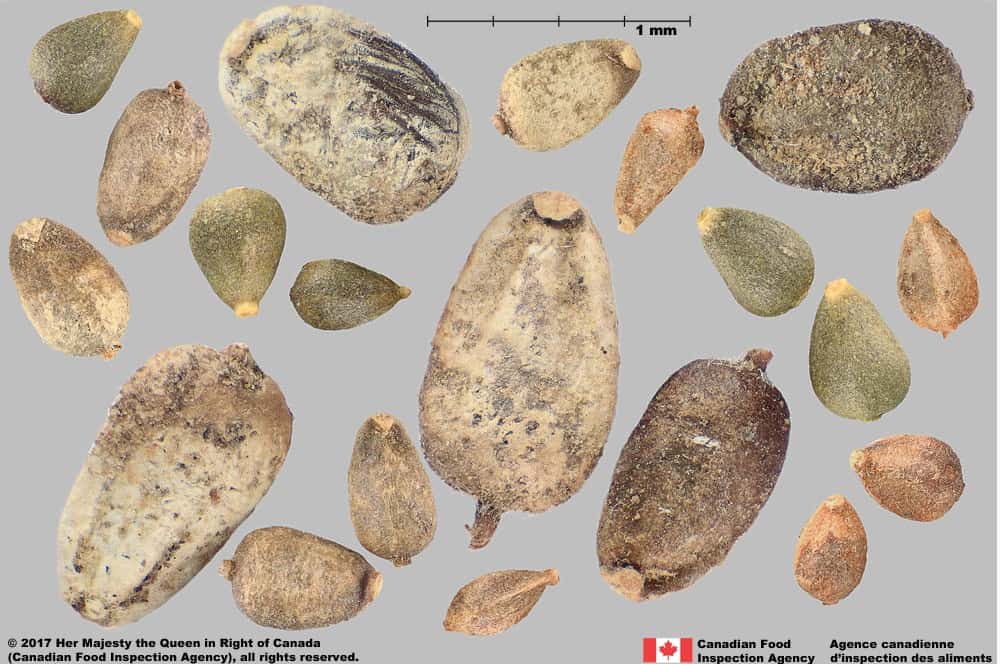Iva axillaris
Overview
Aperçu
Regulation :
Remarques Réglementation:
- Quarantine lists of countries e.g. China *may be updated without notice
Regulation Notes:
On quarantine lists of countries e.g. China*.
*Quarantine lists of countries may be updated without notice.
Distribution :
Répartition :
This species is native to central and western North America and naturalized elsewhere (e.g. Australia) (USDA-ARS 2017; USDA-NRCS 2017).
Habitat and Crop Association :
Habitat et Cultures Associées :
Povertyweed is found in cultivated fields, pastures, prairies and disturbed areas, particularly in seasonally wet, saline soils (FNA 1993+; Darbyshire 2003).
Economic Use, cultivation area, and Weed Association :
Utilisation économique, zone de culture et association de mauvaises herbes :
Duration of Life Cycle :
Durée du cycle vital:
Perennial
Dispersal Unit Type :
Type d’unité de dispersion :
Achene
General Information
RENSEIGNEMENTS GÉNÉRAUX
Povertyweed is a bushy colony-forming plant with creeping roots, and an unpleasant odour (Best 1975). It is common in the prairies, where it can be a persistent weed of agriculture (Best 1975; Frankton and Mulligan 1993; Darbyshire 2003).
.
Iva axillaris plants (Joseph M. DiTomaso, University of California – Davis, Bugwood.org)
Identification
Identification
-
Achene
Size
- Achene length: 1.7 – 4.9 mm (average: 2.6 mm); width: 0.9 – 3.0 mm (average: 1.7 mm)
Shape
- The achene is teardrop to egg-shaped; compressed with ridges
- The tip of the narrow end of the achene is pinched and upturned to one flat side
- Two to three, occasionally four ridges merge together at the narrow end
Surface Texture
- Most achenes have a granular crust on their surface that varies in thickness
- Faint longitudinal striations can be seen on some achenes
Colour
- Achenes are dull; range from light brown to dark brown; some are olive green or almost white
- Some achenes can be a mix of light and dark brown colours
- The attachment point is often a lighter colour than the achene
Other Features
- Style appendage at wide end of achene appears as a small knob

Povertyweed (Iva axillaris) achenes






Identification Tips
CONSEILS POUR L’IDENTIFICATION
Additional Botany Information
AUTRES RENSEIGNEMENTS BOTANIQUES

Iva axillaris flowers (Steve Dewey, Utah State University, Bugwood.org)




Similar Species
ESPÈCES SEMBLABLES
Similar species are based on a study of seed morphology of various species, and those with similar dispersal units are identified. The study is limited by physical specimen and literature availability at the time of examination, and possibly impacted by the subjectivity of the authors based on their knowledge and experience. Providing similar species information for seed identification is to make users aware of similarities that could possibly result in misidentification.
Cyclachaena xanthiifolia (false ragweed)
Cyclachaena xanthiifolia achenes are a similar size and shape as povertyweed with merging ridges and an upturned tip at the narrow end that is light coloured.
Cyclachaena xanthiifolia achenes are darker in colour, have a style base that is a more obvious peg, and they generally lack the granular crust of povertyweed. The striations on the surface are very conspicuous in comparison to the faint ones occasionally seen in povertyweed. False ragweed has a size range (length: 1.9 – 3.0 mm; width: 0.9 – 1.9 mm) that overlaps with that of povertyweed, but the latter species has more size variation.
Click to select species
Cliquez pour sélectionner les espèces

Cyclachaena xanthiifolia
Comparison Window
Fenêtre de comparaison
MAIN SPECIES
ESPÈCES PRINCIPALES
Iva axillaris

Iva axillaris
Asteraceae
Povertyweed (Iva axillaris) achenes
MAIN SPECIES
ESPÈCES PRINCIPALES
Iva axillaris

Iva axillaris
Asteraceae
Povertyweed (Iva axillaris) achenes
MAIN SPECIES
ESPÈCES PRINCIPALES
Iva axillaris

Iva axillaris
Asteraceae
Povertyweed (Iva axillaris) achenes
MAIN SPECIES
ESPÈCES PRINCIPALES
Iva axillaris

Iva axillaris
Asteraceae
Povertyweed (Iva axillaris) achene
MAIN SPECIES
ESPÈCES PRINCIPALES
Iva axillaris

Iva axillaris
Asteraceae
Povertyweed (Iva axillaris) achene
MAIN SPECIES
ESPÈCES PRINCIPALES
Iva axillaris

Iva axillaris
Asteraceae
Povertyweed (Iva axillaris) achene; side view
MAIN SPECIES
ESPÈCES PRINCIPALES
Iva axillaris

Iva axillaris
Asteraceae
SIMILAR SPECIES
ESPÈCES SEMBLABLES
Cyclachaena xanthiifolia

Cyclachaena xanthiifolia
Asteraceae
False ragweed (Cyclachaena xanthiifolia) achenes
SIMILAR SPECIES
ESPÈCES SEMBLABLES
Cyclachaena xanthiifolia

Cyclachaena xanthiifolia
Asteraceae
False ragweed (Cyclachaena xanthiifolia) achenes
SIMILAR SPECIES
ESPÈCES SEMBLABLES
Cyclachaena xanthiifolia

Cyclachaena xanthiifolia
Asteraceae
False ragweed (Cyclachaena xanthiifolia) achene
Need ID Help?
Besoin d’aide pour l’identification?
Reference(s)
Référence(s)
Best, K. F. 1975. The Biology of Canadian Weeds. 10. Iva axillaris Pursh. Canadian Journal of Plant Science 55: 293-301.
Darbyshire, S. J. 2003. Inventory of Canadian Agricultural Weeds. Agriculture and Agri-Food Canada, Research Branch. Ottawa, ON.
Flora of North America (FNA) Editorial Committee, eds. 1993+. Flora of North America North of Mexico [Online]. 22+ vols. New York and Oxford. http://beta.floranorthamerica.org. Accessed April 25, 2017.
Flora of North America (FNA) Editorial Committee, eds. 1993+. Flora of North America North of Mexico [Online]. 22+ vols. New York and Oxford. Accessed December 29, 2022.
Frankton, C. and Mulligan, G. A. 1993. Weeds of Canada. Agriculture Canada, Publication 948, Ottawa, ON. 217 pp.
Global Biodiversity Information Facility (GBIF) Secretariat. 2022. https://doi.org/10.15468/39omei Accessed via https://www.gbif.org/species/5402631 Accessed December 29, 2022.
U.S. Department of Agriculture-Agricultural Research Services (USDA-ARS). 2017. Germplasm Resources Information Network (GRIN), https://npgsweb.ars-grin.gov/gringlobal/taxon/taxonomysearch Accessed April 25, 2017.
U.S. Department of Agriculture-Natural Resources Conservation Service (USDA-NRCS). 2017. The PLANTS Database. National Plant Data Team, Greensboro, NC USA. https://plants.usda.gov/home Accessed April 25, 2017.




